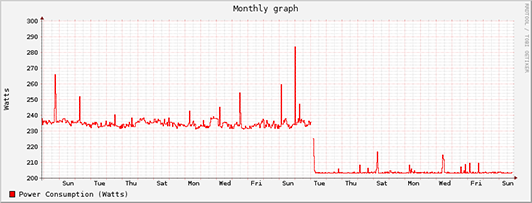2.5″ enterprise hard drives and power savings
I admit it – I used to have an unwarranted prejudice against 2.5″ enterprise hard drives, considering them “toy” drives, or at best suited for notebook use, or non-critical use in enterprise systems. I used WD Velociraptor drives on my Dell desktops (before I upgraded to SSDs), but that particular model was discontinued, and the WD web site has this discouraging note about the current models: “Models WD1000CHTZ, WD5000BHTZ and WD2500BHTZ are available on a build to order basis, contact your WD Sales representative for more information.” which I interpreted as “people aren’t buying these, but if you want a bazillion of ’em, we’ll restart the production line”. I also used WD 2.5″ drives as the operating system volume on my RAIDzilla II file servers, but the actual data volumes were built with 16 x 2TB 3.5″ drives.
However, in an attempt to reduce power consumption here, I decided to test 2.5″ enterprise drives as a replacement for identical-capacity 3.5″ drives, and the results were surprising (to me, at least). I upgraded one of my Dell PowerEdge R710 systems (gate.glaver.org, the system that is serving this web page that you’re reading) from 6 x 146GB 15K RPM 3.5″ SAS drives (ST3300657SS-H*) to 6 x 146GB 15K RPM 2.5″ SAS drives (ST9146852SS). All other components remained the same*. The drives are in a 5-drive RAID5 array controlled by a Dell PERC H700 controller, with the 6th drive being a dedicated hot spare.
Power consumption on this busy system dropped from 237W to 204W and became much more even (apparently, seeking on the 3.5″ drives consumes much more power than on the 2.5″ drives):
The PowerEdge R710 is already a pretty efficient system – this particular box has 2 x X5680 6-core Xeon CPUs, 48GB of registered ECC RAM, hardware RAID controller, etc.
Even more surprising was the discovery that disk I/O was still very fast, at well over 600MByte/sec:
(0:1) gate:~terry# dd if=/dev/mfid0 of=/dev/null bs=1m count=102400
102400+0 records in
102400+0 records out
107374182400 bytes transferred in 171.422439 secs (626371804 bytes/sec)
Based on this, I will certainly give serious consideration to using 2.5″ drives in future builds.
Seagate has announced 2.5″ enterprise drives with up to 2TB capacity (in both SAS and SATA variants). While that is lagging behind the announced capacity for 3.5″ drives (8TB at this time), you can fit a lot more 2.5″ drives in a given chassis. I expect to use one or two additional drive generations in my existing RAIDzilla II chassis (upgrading to 4TB drives at some point, and then in the future to 8TB or 10TB drives). After that, it will be time to design the RAIDzilla III.
* Yes, I know this is normally a 300GB drive. Seagate didn’t make a native 146GB drive in the Cheetah 15K.7 family, and the -H suffix indicates a half-capacity drive for OEMs who needed to match existing drive capacities.
* This is not a particularly easy conversion, as the Dell chassis for the R710 is not modular. However, various sellers on eBay are selling new or used 2.5″ chassis (part number 33P6Y). You can move just about all of the old components from the 3.5″ chassis over – the only item you will need (other than the actual 2.5″ drives and trays) are the appropriate cables from the drive backplane to the RAID controller. For a PERC H700, that is 2 x R145M mini-SAS cables.

